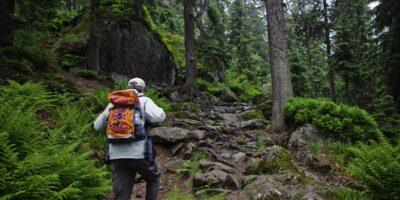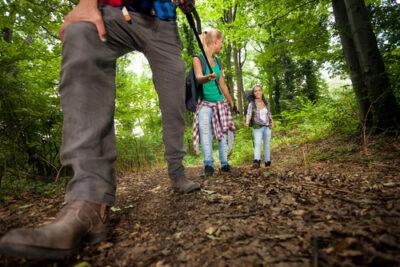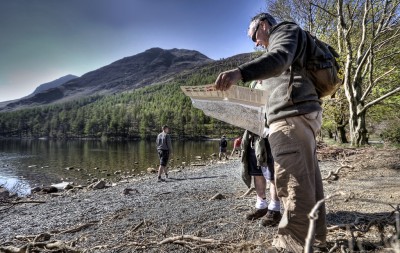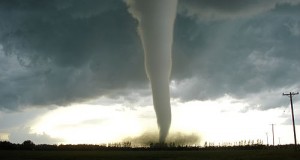
Image source: galleryhip.com
You don’t necessarily have to know 200 ways to sharpen a knife, but if you’re new to the art of bushcraft/survival you will want to make sure that you’ve got a few of the basics out of the way prior to your first serious group outing in the backwoods.
This knowledge also is important for any survivalist for the simple fact that it can be useful for anything from a time when you’re lost in the wilderness to a bugout operation when the big one hits. The five following skills are critical areas of study to master before you find yourself in the middle of nowhere.
No. 5: Tracking
The science and art of tracking is basically the study of how to interpret what the land is telling you about recently transpiring events within the immediate vicinity. Whether it’s a fallen tree, a deer track, a human footprint or a broken twig, the land itself tells a story. And you need to learn how to read that story. Trackers are essentially detectives, but without the chalk outlines and paperwork.
Tracking knowledge is not just needed for hunting and trapping. If you know what you’re doing, you’d be able to tell if there’s a nearby human presence (which would be a critical skill during a bugout situation). This is one reason why elite combat units learn tracking – it helps them determine troop strengths and their corresponding movements.
No. 4: Weather
A few years back, I had mulled over the idea of purchasing an altimeter wristwatch. I wanted the slight edge of being able to predict immediate changes in local weather. Let’s face it, knowing what the weather is going to do on any given day would give me a HUGE advantage, especially during a 24/7 post-bugout situation.
Well, it didn’t take me long to realize that I’d have to drop at least $200 to get one that actually worked the way I needed it to. After I spoke with the owner of the hiking store I frequented, he literally said: “Dude, I wouldn’t get one. For why you need it, just learn to study the clouds.”

Image source: survivalbased.com
What a novel thought, right? Needless to say, knowing how to predict the weather while in the field is a huge necessity. But purchasing expensive gear in order to do so is not. If you learn how to interpret signs in the sky, then you’ve just saved yourself a pretty penny on gear you didn’t actually need in the first place.
No. 3: Shelter and Fire
These two topics are probably the most obvious on this list because exposure is one of the biggest killers in the field. If you can’t build a fire then you could be up a creek, especially when the temperatures begin to plummet.
The Secret To Starting Fires In Even The Most Extreme Conditions
This skill will be your key advantage in everything from signaling for help to cooking your day’s catch. Perhaps the most commonly held requirement in the business is that you should know at least five ways to build a fire, including at least three “primitive” methods.
Having shelter, like having fire, is crucial for staving off hypothermia. If properly built, your shelter should also keep you dry during rainy nights. It’s also a way to keep that sleep-robbing mental boogie man at bay while you’re out there in no man’s land. In order to be prepared, I recommend knowing how to build the basics: a debris hut, lean-to, A-frame, and wickiup are common but time-tested shelters.
No. 2: First Aid
Think about it. If you’re in a survival situation, then how did you probably end up in that predicament in the first place? It’s usually because something unpredictable happened, like capsizing your canoe on the Snake River or flipping your sedan in the Adirondacks. And when people find themselves in these scenarios, injuries are usually an accompanying factor.
If you’re well-studied in first aid, then you’ll know precisely what to do when somebody on your team (or you) is bleeding, has a broken bone, or desperately needs their body’s core temperature increased after a fall into that breathtakingly frigid mountain river.
By the way, having even basic medical knowledge will make you indispensable in a disaster scenario. Your team might just want to do their due diligence in protecting the one guy that knows how to fix a nasty knife wound.
No. 1: Land Navigation
This is my No. 1 for a very, very good reason.
Ultra-Efficient Water Filter Fits In Your Pocket!

Image source: oars.com
If you’re in a 72-hour survival scenario, and ESPECIALLY if you’re rolling full-steam toward your retreat, then there’s no way you’ll succeed in arriving safely at your intended destination without knowing where you’re going. Quite frankly, if you have no clue how to get around without your GPS, then you might as well have just stayed home in relative safety.
Getting lost could walk you right into hostile situations. It also will increase your bugout time during a very chaotic and dangerous time. And worst of all, you might not even make it to your retreat because you run out of roads to follow. Following a road is easy. Moving from point “A” to “B” over dense, foliage-covered land is not, especially if you have little or no experience in doing so.
In the same way, knowing how to orient yourself after you just wound up on a river bank, soaking wet with all your gear being churned with the rapids could profoundly reduce the time it takes to get you back home.
Let’s Get After It
Getting where you’re going and accomplishing this in a non-bleeding or broken or freezing or dehydrated or lost fashion is always the primary objective. So study up on Google, YouTube or any of the many other resources out there and get prepared.
What would you add? Share your suggestions in the section below:
Could You ‘Live Off The Land’ With Your Gun? Read More Here.
 Off The Grid News Better Ideas For Off The Grid Living
Off The Grid News Better Ideas For Off The Grid Living




